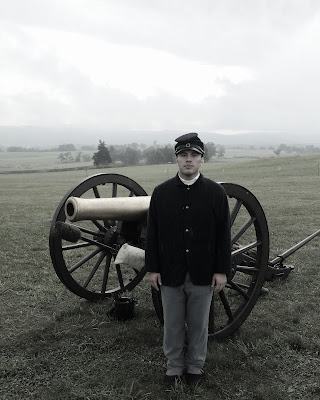 |
| Myself in Infantry Garb |
The programs were volunteer led, but
for safety they were overseen by a black powder certified ranger. Often times
the living history members cannot invest in a cannon for demonstration because
of the expense. However, Antietam had its own Napoleon Cannon for the purpose
of artillery demonstrations. So the lucky people who love to take part in
demonstrations are able to be more than an infantry group and organize into an
artillery battery. I was fortunate enough to work with the Battery B living
history group, which is incredibly respected amongst staff at Antietam
Battlefield. I knew most members of the group from working the visitor center
desk with them. The group goes beyond investing their time in demonstrative
practices, by also aiding in interpretation of the unit through fielding questions
at the front desk and/or giving battlefield tours. Their knowledge of artillery procedure
and of the battle was striking. During the time spent drilling I couldn’t help
chuckling at their quirky Civil War general jokes and awing at their accounts
of soldier's heroism.
 |
| My roommate and I |
 |
| Quarter Scale Napoleon in Display Case |
I aided in two demonstrations. The
demonstration consisted of an opening fire, a lecture of the character of
artillery men during battle and their responsibilities, another firing, a
lecture of the specific group we were representing by being there, and a final
firing. After the final fire, we dropped the ropes and fielded questions from visitors
who came to watch. I participated as the number five, meaning I was the ammunition
runner. The ammunition runner places the round in the worn haversack from
the ammunition chest and advances it to the cannon. Before getting to the
cannon, I stopped and had my round inspected by the gunner who stood between
the cannon and the ammunition chest. The gunner was sort of the captain to the
team and was responsible in calling out coordinates and type of ammunition to be used.
Battery B was a Union artillery
regiment. Antietam Battlefield also has a Confederate artillery group that
travels to use the battlefield’s cannon for demonstrations. I worked safety line for their demonstrations a number of times throughout the summer. I think it is
important to have both sides of the battle represented and I certainly enjoyed
seeing the variance in uniform and presentation. Speaking of uniforms, that
wool really sucks the life out of you. But the heat was a small sacrifice to make for being
able to have firsthand experience in something as unique as living history.
Thank you
Battery B for allowing me the experience!
Thank you Christie
and Rory for coordinating it!
 | |
|

No comments:
Post a Comment